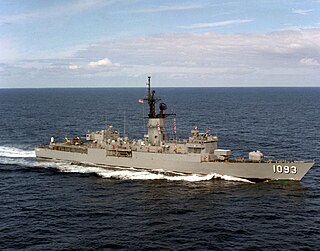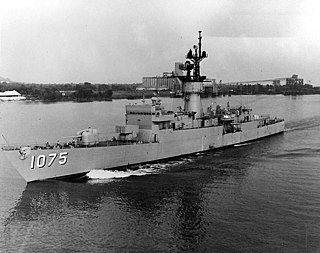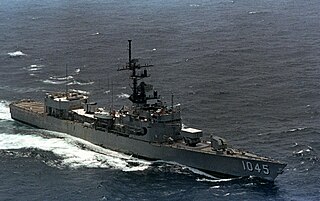
USS Brinkley Bass (DD-887) was a Gearing-class destroyer in service with the United States Navy from 1945 to 1973. She was then transferred to Brazil where she served as Mariz e Barros (D-26) until 1997. The destroyer was finally sunk as a target in 2000.

The second USS Henry W. Tucker (DD-875) was a Gearing-class destroyer of the United States Navy.

USS Perkins (DD/DDR-877) was a Gearing-class destroyer in the United States Navy. She was the third Navy ship named for Commodore George H. Perkins USN (1835–1899).

USS Whipple (DE-1062/FF-1062) was a Knox-class frigate commissioned in the United States Navy from 1970 to 1995. In 2002, Whipple was donated to the Mexican Navy and renamed ARM Mina (F-214).

Garcia-class frigates were United States Navy warships. These frigates were originally ocean escorts bearing the hull classification DE until 1975. The ships were commissioned between 1964 and 1968 and decommissioned between 1988 and 1990.

USS Nicholas (DD/DDE-449) was a Fletcher-class destroyer of the United States Navy, serving for a total of 27 years, including through most of World War II, the Korean War, and the Vietnam War. She was the second Navy ship to be named for Major Samuel Nicholas.

USS Albert David (FF-1050) was a Garcia-class destroyer escort, later reclassified as a frigate, in the United States Navy. She was named for Lieutenant Albert David, a Medal of Honor recipient. His was the only Medal of Honor awarded to a member of the Navy in the Atlantic Theater of Operations in World War II. Laid down on 28 April 1964 and commissioned on 19 October 1968, Albert David served in the Pacific, including performing gunfire support operations in Vietnam during the 1970s. She was briefly deployed to the Arabian Sea in September and October 1982. On 18 September 1989 she was leased to the Brazilian Navy, and then sold to Brazil where she served as the destroyer Pará until 12 November 2008 when she was decommissioned and put in reserve. She appears to have been scrapped as of 2015.

USS Guest (DD-472), a Fletcher-class destroyer, was a ship of the United States Navy named for Commodore John Guest (1822–1879).

USS Walker (DD-517), a Fletcher-class destroyer, was the second ship of the United States Navy to be named for Admiral John Grimes Walker (1835–1907).

Destroyer leader (DL) was the United States Navy designation for large destroyers from 9 February 1951 through the early years of the Cold War. United States ships with hull classification symbol DL were officially frigates from 1 January 1955 until 1975. The smaller destroyer leaders were reclassified as destroyers and the larger as cruisers by the United States Navy 1975 ship reclassification so destroyer escorts could be reclassified as frigates (FF) in conformance with international usage of the term.

The third USS Blakely (DE-1072/FF-1072) was a Knox-class destroyer escort in the United States Navy. She was reclassified as a frigate in 1975 along with her entire class. Her primary mission of ASW remained unchanged. She was named for Captain Johnston Blakeley and Vice Admiral Charles Adams Blakely. She was primarily stationed out of Charleston, South Carolina.

USS Badger (FF-1071) was a Knox-class frigate in service in the United States Navy from 1970 to 1991. She was sunk as a target in 1998.

USS Capodanno (FF-1093) was the 42nd Knox-class frigate in the United States Navy. It was named after Fr. Vincent Capodanno, recipient of the Medal of Honor.

USS Wiltsie (DD-716) was a Gearing-class destroyer in the United States Navy. She was named for Irving Wiltsie. The destroyer entered service in 1946 and remained active with the United States Navy until 1977, when Wiltsie was decommissioned and sold to Pakistan in 1977. The vessel entered service with the Pakistan Navy as PNS Tariq (D165) in 1978. In 1990, the ship was renamed PNS Nazim to allow the name Tariq to be given to a newly-acquired Type 21 frigate. The ship was then transferred to the Pakistan Maritime Security Agency and used as an alongside "at sea" headquarters for the agency. Though afloat, the vessel no longer sails.

USS Richard B. Anderson (DD-786) was a Gearing-class destroyer of the United States Navy, named for USMC Private First Class Richard B. Anderson (1921–1944), who was posthumously awarded the Medal of Honor for heroism during the Battle of Kwajalein.

USS Everett F. Larson (DD/DDR-830) was a Gearing-class destroyer of the United States Navy, named for Private First Class Everett F. Larson (1920–1942) who was killed in the Guadalcanal campaign.

USS Meyerkord (FF-1058) was a Knox-class frigate in service with the United States Navy from 1969 to 1991. She was scrapped in 2001.

USS Trippe (FF-1075) was a Knox-class frigate of the US Navy, built at Westwego, Louisiana, was commissioned in mid-September 1970. In July 1971, following shakedown training in the Caribbean area and a surveillance mission off Haiti, she entered the Boston Naval Shipyard for overhaul and installation of the Basic Point Defense Missile System, which featured short-range "Sea Sparrow" guided missiles in an eight-round launcher on her afterdeck. Trippe was the Navy's first destroyer-type ship to receive this later-widespread contribution to shipboard protection against air and missile attack. The first months of 1972 were spent testing her new weapons and participating in exercises. In June the ship passed through the Panama Canal en route to Southeast Asian waters, where she provided Vietnam War aircraft carrier escort and naval gunfire support services during July and August. Trippe then went to the Indian Ocean and Persian Gulf areas, visiting many ports in a region that would see increasing U.S. Navy activity in the coming decades. She returned to the U.S. East Coast in December 1972, after a deployment that had taken her completely around the World.

USS Davidson (FF-1045) was a Garcia-class destroyer escort, and later a frigate, in the United States Navy. She was named for Vice Admiral Lyal A. Davidson. Davidson was commissioned with the US Navy from 1965 to 1988 and served with the Brazilian Navy from 1989 to 2002. Davidson sank while under tow to be scrapped in India circa in 2005.

USS Sample (FF-1048) was a frigate in the US Navy and the seventh in its class named for William Dodge Sample who was a Rear Admiral in the United States Navy and an Escort Carrier Division commander in World War II. He was the youngest rear admiral in the Pacific Theater of World War II. It was laid down in 1963 and decommissioned in 1988, then transferred to Brazil in 1989.





















